2025 Conference on Robot
Learning
September 27 – 30, 2025 | Seoul, Korea

Tour

Korea is a vibrant destination offering unique attractions and rich cultural experiences.
General Announcement
- The Tour programs are exclusively available to CoRL 2025 participants.
- Tour Reservation Deadline: August 24, 2025
- All optional tour programs require a minimum of 20 participants. If the minimum number is not met, or in the case of adverse weather conditions such as typhoons, heavy rain, etc., the program may be cancelled or substituted with an alternative tour. Participants will be notified in advance. Alternatively, the program may proceed at an adjusted rate, subject to the consent of all participants.
- All tours include entrance fees as specified in the itinerary and will be conducted with the service of an English-speaking guide.
- Pick-up & Drop-off Location: To be announced.
Cancellation Policy
- Cancellation request before August 24, 2025: Refundable
- Cancellation request after August 25, 2025 or No-show: Non-refundable
* Note: A no-show refers to failure to attend the tour without prior notice.
For inquiries regarding tours, please contact the Housing & Tour Bureau at the details provided below.
Housing & Tour Bureau of CoRL 2025 / GTN Co., Ltd
E-mail: corl2025.tb@gmail.com Tel. +82-2-6954-0883
Rm# 825, 8F Officia B/D, 92 Saemunan-ro, Jongno-gu, Seoul, Republic of Korea
Housing & Tour Bureau of CoRL 2025 /
GTN Co., Ltd
E-mail: corl2025.tb@gmail.com
Tel. +82-2-6954-0883
Rm# 825, 8F Officia B/D, 92 Saemunan-ro,
Jongno-gu, Seoul, Republic of Korea
Tour Programs
(KRW)
(Yoeuido ↔ Banpo Bridge)
- N Seoul Tower Observatory
- Deoksugung Palace
- Hanbok Return - Gwangjang Market
– Insa-dong Culture Street
- The Garden of Morning Calm
Make Tour Reservation
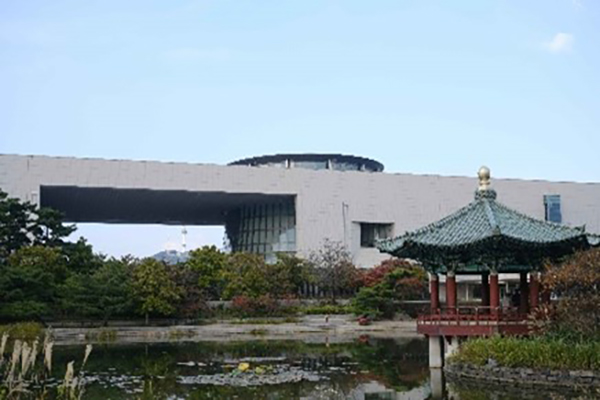
The National Museum of Korea houses over 420,000 artifacts spanning various subjects, from world heritage items to cultural treasures, covering periods from ancient times to the present.
You can enjoy the magnificent gold crowns from the Three Kingdoms period, exquisite celadon from the Goryeo dynasty, Joseon-era paintings, photographs documenting modern history, and the tranquil beauty of the museum’s gardens, which feature stunning landscapes and waterfalls.
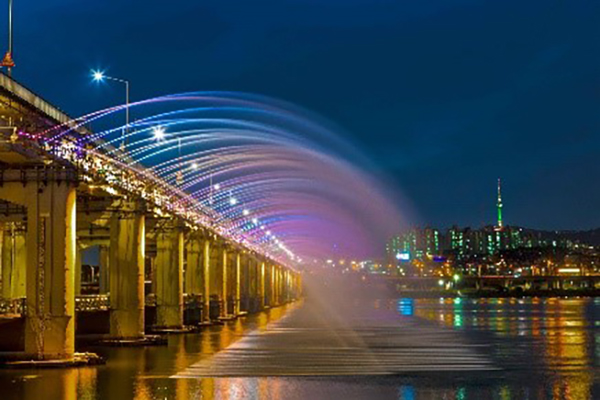
Han River Cruise spans the length of the Han River, flowing across the Korean Peninsula from east to west. It is the fourth-longest river in Korea, following the Yalu, Tumen, and Nakdong rivers.
Moonlight Music Cruise offers a romantic experience along the river, passing iconic landmarks such as the Han River Bridge, Banpo Bridge, Sebitseom Island, and Nodeul Island. Guests can enjoy the serene night views of the river, accompanied by live performances, while taking in the sights of landmarks like the N Seoul Tower, 63 Square, and the Banpo Rainbow Fountain.
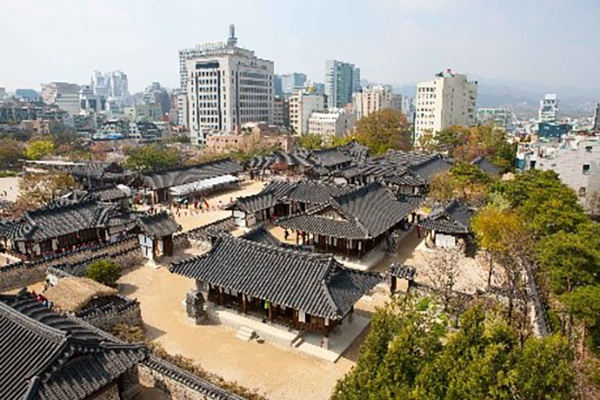
Namsangol Hanok Village is a collection of five hanok from the Joseon Dynasty, relocated from various parts of cities to the northern foot of Namsan Mountain. In the middle of a bustling city center, visitors can immerse themselves in Korean traditional culture through hands-on experiences. The village is beautifully landscaped with valleys, pavilions, and a variety of flowers and plants arranged in a traditional style.

N Seoul Tower was built in 1969 as Korea’s first integrated transmission tower for television and radio broadcasts, was opened to the public in 1980. The tower has since become one of Seoul’s most iconic landmarks, renowned for its height and distinctive design. The observatory offers panoramic views of the city skyline, making it a favorite destination for both domestic and international visitors. The Namsan Cable Car provides a convenient and enjoyable way to reach the top, adding to the tower’s appeal as a must-visit attraction.
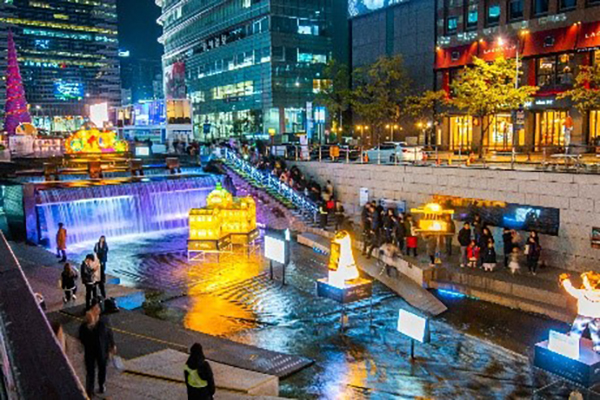
Cheonggyecheon Stream is a 10.9-kilometer-long stream and public space located in downtown Seoul, South Korea. Historically, it served as part of Seoul’s early sewerage system until the mid-20th century. Today, Cheonggyecheon Stream is a beloved urban oasis. Notable features include the Candle Fountain in Cheonggye Plaza, a two-tiered waterfall that cascades 4 meters, and a 1/100 scale miniature model of the entire stream, providing visitors with a unique perspective of the area.
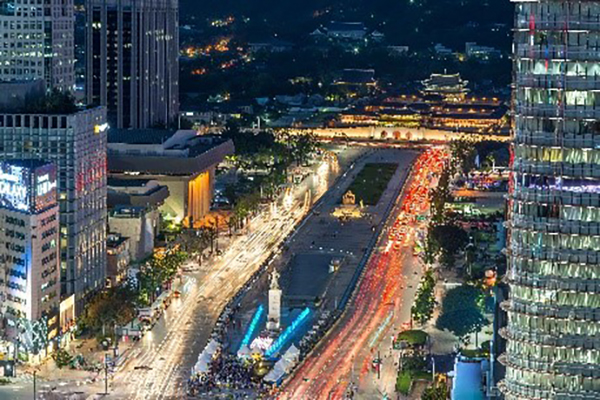
Gwanghwamun Square reopened to the public in August 2022 following extensive renovation, is a central cultural and historical landmark. Sejong-ro, the main thoroughfare in Seoul with a 600-year history, has been transformed into a space for historical and cultural experiences.
The square is historically significant as the site of royal administrative buildings, known as Yukjo-geori or the “Street of Six Ministries.” It also features statues of Admiral Yi Sun-sin, a hero of the Joseon Dynasty, and King Sejong the Great, one of Korea’s most revered monarchs.
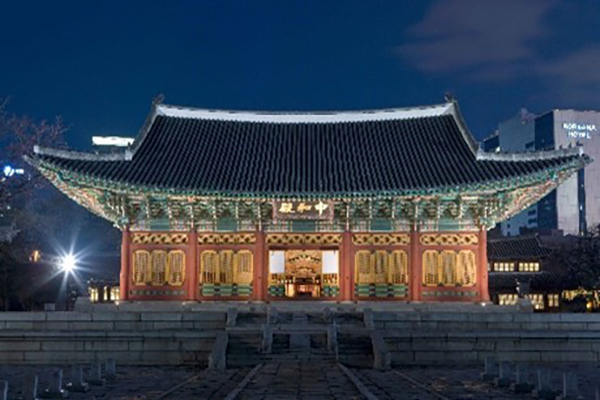
Deoksugung Palace was originally not a royal residence but the home of Grand Prince Wolsan, the older brother of King Sejong of the Joseon Dynasty. Over time, it became a royal palace and retained its significance as a cultural heritage site. The palace uniquely blends traditional Korean and Western classical architectural styles. It once served as the residence of kings during the Joseon Dynasty and the Korean Empire. Today, the peaceful and stunning night view of Deoksugung Palace makes it a popular resting place and a beloved attraction for both locals and tourists alike.
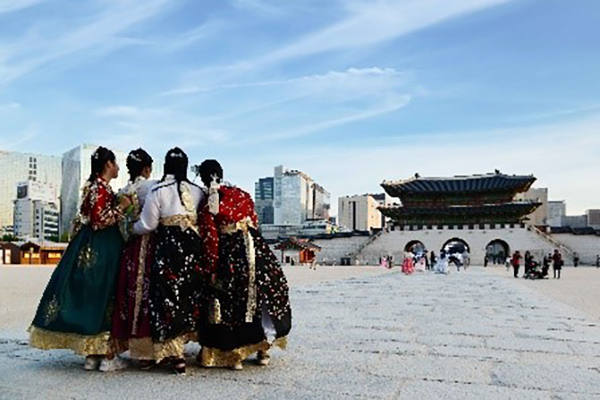
Hanbok is the traditional clothing of the Korean people, with a history as rich and vibrant as the garments themselves. Recently, hanbok has become a trend in street fashion and music videos. The growing trend of foreign tourists wearing hanbok while visiting Gyeongbokgung Palace has increased its popularity. More than simply traditional attire, wearing hanbok provides a unique opportunity to immerse oneself in the rich cultural heritage and history of Korea.
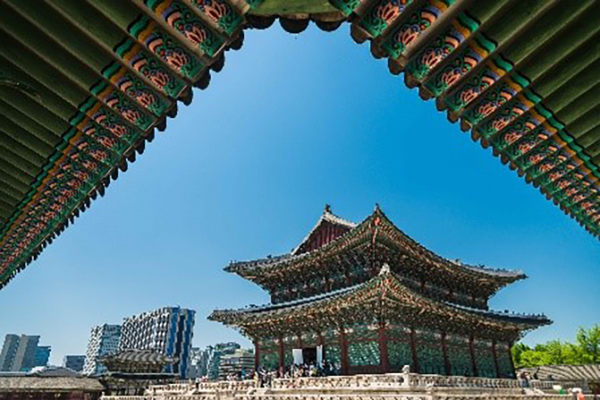
Gyeongbokgung Palace was the first and largest of the royal palaces built during the Joseon Dynasty. It was constructed in 1395 by King Taejo, the founder of the Joseon Dynasty. Strategically located at the heart of Seoul, the newly appointed capital, Gyeongbokgung served as the main royal residence. It faces Namsan and Cheonggyecheon, with Mt. Bukak forming its scenic backdrop. As you explore the beautiful buildings and gardens, you can experience the deep history of Korea’s dynasties.
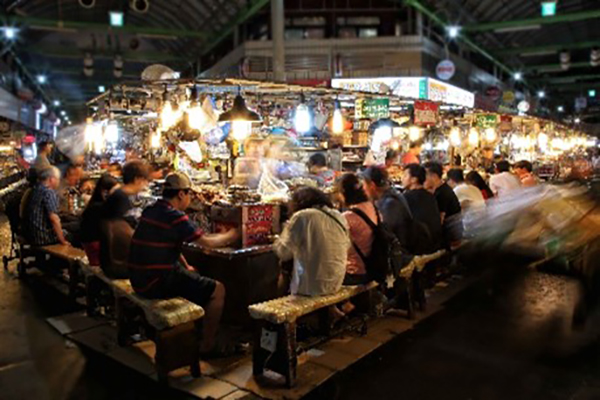
Gwangjang Market, the first permanent market in Korea, continues to thrive as a popular tourist destination. The name Gwangjang means “to gather from afar and keep altogether,” reflecting its origin as a small trading center that brought goods from neighboring regions. Today, it has expanded into a large wholesale market offering a wide variety of goods. The food market is the busiest and most famous part, attracting a diverse crowd, including foreign tourists, locals, and students.
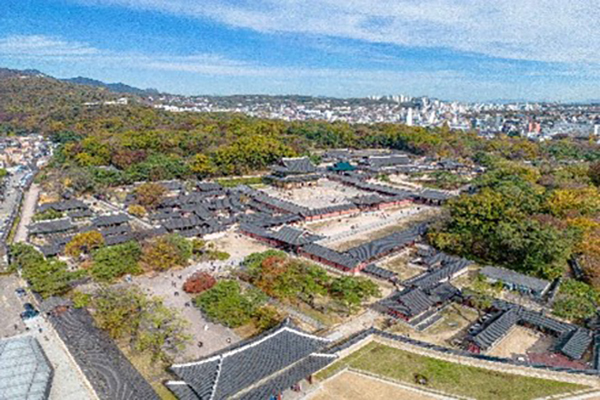
Changdeokgung Palace was built in 1405 as a secondary palace to Gyeongbokgung Palace. It was destroyed during the Japanese invasion of 1592 and subsequently rebuilt in 1610. Often referred to as Donggwol (East Palace), it had no boundaries separating it from Changgyeonggung Palace. This 600-year-old UNESCO World Heritage Site is one of Seoul’s most treasured landmarks, celebrated not only for its exquisite architectural details but also for its expansive, verdant gardens, which exemplify traditional Korean palace design.
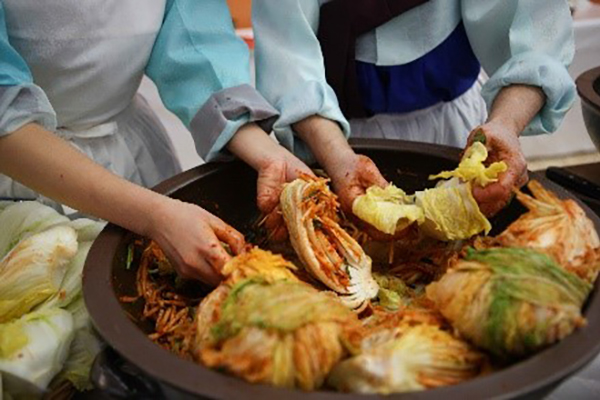
Museum Kimchikan originally opened in 1986 as the Kimchi Museum and relocated to Coex Mall before reopening in Insadong in 2015 under its current name. The name “Kimchikan” combines kimchi one of the world’s top five healthiest foods (Health, 2006) with “kan”, meaning “space” in Korean. At the museum, visitors can explore the history, flavors, and nutritional value of kimchi and experience kimjang culture, recognized as an intangible cultural heritage. Guests have the opportunity to make and taste kimchi with an expert and take home their creation in a provided container.
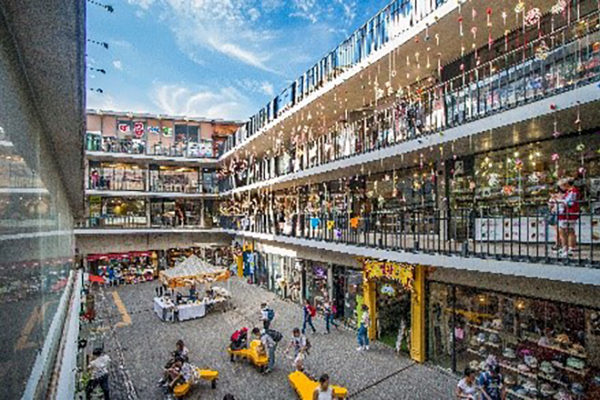
Insa-dong Culture Street is a vibrant tourist destination, famous for its numerous art galleries, traditional teahouses, restaurants, and street vendors. Its most distinctive feature is the widespread use of Hangeul on storefronts, which adds to the area’s charm and allows visitors to connect with the unique culture and spirit of the neighborhood.
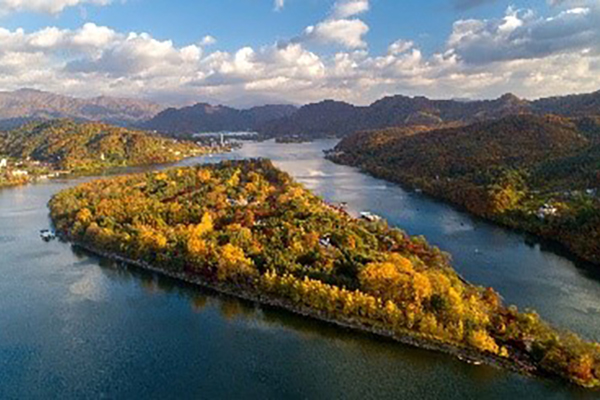
Nami Island is a picturesque destination that can be visited year-round. Famous for its appearance in numerous Korean dramas, the island is home to a variety of tree-lined paths, including lanes lined with pine trees, ginkgo trees, and towering redwoods. Visitors can enjoy a scenic walk along the wooden riverside path or take a photo with the Winter Sonata statue in Gongsaengwon Garden. The island can be reached by ferry or via one of Korea’s longest ziplines.
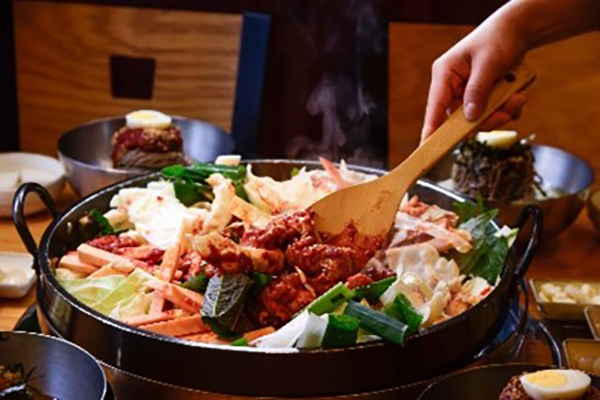
Dak-galbi is a popular South Korean dish made by stir-frying marinated diced chicken in a spicy gochujang-based sauce with sweet potatoes, cabbage, perilla leaves, scallions, rice cakes (tteok), and other ingredients. Although “dak” means chicken and “galbi” refers to ribs, dak-galbi does not actually contain chicken ribs. Instead, it is a dish made by boneless chicken stir-fried with vegetables and rice cakes. Chuncheon, the city where Nami Island is located, is famous for its delicious dak-galbi.

The Garden of Morning Calm was founded by Professor Sang-kyung Han, an honorary professor at the Department of Horticulture, Sahmyook University. The garden, which opened on May 11, 1996, as a private venture, aims to showcase the natural beauty of Korea, along with oriental mysticism and the spirit of the Korean people. The design of the garden emphasizes curves, open spaces, and asymmetric balance, reflecting Korea’s unique aesthetic and a sense of classic elegance.
© Images provided by Korea Tourism Organization Photo Korea